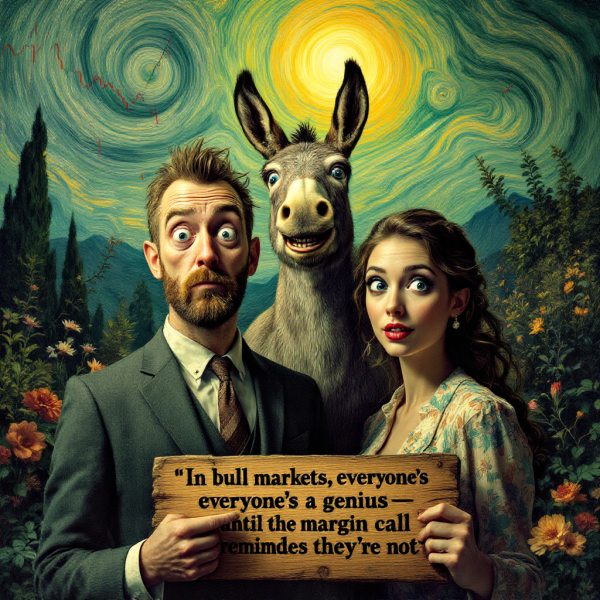Mass Stupidity in Markets: Do the Opposite or Get Burned
July 17, 2025
There’s a certain stench to market euphoria. You can smell it—the arrogance, the TikTok pumpers, the Uber driver giving stock tips, the neighbour’s kid flipping NFTs and talking about “generational wealth.” Mass stupidity doesn’t knock. It parades in, loud and proud, with confetti and hashtags. The lemmings chant “this time is different” right before jumping. Strangers are printing Lambos, CNBC is running “how to get rich quick” specials, and the only thing missing is caution.
Mass stupidity isn’t random—it’s cyclical. It’s as old as markets themselves. When it peaks, it devours everything in its path: portfolios, reputations, even entire economies. When crowds unite under delusion, disaster follows. Smart traders don’t fight it—they front-run its failure. The crowd’s always wrong at extremes, and the only question is whether you’ll be the one holding the bag or the one selling it.
What Is Mass Stupidity in Markets?
Mass stupidity isn’t simple ignorance. It’s a willful suspension of disbelief—a collective agreement to ignore reality in favour of the story everyone wants to believe. It’s not just a lack of knowledge; it’s the active rejection of inconvenient truths. Herd thinking takes over, driven by greed, FOMO, and the intoxicating power of social proof.
Howard Marks, a master of cycle awareness, puts it bluntly: “First-level thinkers ask ‘will it go up?’ Second-level thinkers ask ‘what’s priced in?” Mass stupidity is the domain of first-level thinking. It’s the crowd asking the wrong questions, convinced that the answer is always “higher.”
Charles Mackay wrote about this centuries ago in Extraordinary Popular Delusions and the Madness of Crowds. Tulip mania, South Sea Bubble, tech stocks, meme manias, NFTs—the costumes change, but the script stays the same. The crowd wants to believe, so it does, right up until reality smashes the illusion.
Behavioural Triggers That Fuel It
Mass stupidity is a behavioural bonfire, and the fuel is always the same:
Recency bias leads the crowd to believe that the current trend will last forever. If stocks have gone up for a year, they’ll go up forever. If crypto doubles in a month, it’ll likely double again. The past becomes the future, no matter how absurd.
Confirmation bias ensures that only the voices with a bullish perspective are heard. Dissenters are mocked, muted, or blocked. The crowd builds an echo chamber, and every new high is proof that the narrative is right.
Overconfidence is the accelerant. Early success breeds arrogance. The crowd doubles down, convinced they’re geniuses. Risk management goes out the window. Why hedge when you can 10x?
Groupthink is the final nail. Nobody wants to be left out. FOMO trumps logic. The herd moves as one, and anyone who hesitates gets trampled.
Michael Burry, who saw the 2008 housing collapse coming, put it: “The housing market was a castle of sand—everyone chose not to see it.” Mass stupidity isn’t about not knowing. It’s about not wanting to learn.
Key Market Examples
Dot-Com Bubble (1999–2000)
The late 1990s were a fever dream. Pets.com went public with no earnings and a sock puppet mascot, raising $300 million. The retail crowd demanded exposure to anything with “.com” in the name. Analysts hyped up companies with no revenue, no plan, and no future. The Nasdaq soared, then crashed 78%. The crowd lost their shirts and never saw it coming. The lesson? Mass stupidity doesn’t just lose money—it vaporises it.
2008 Housing Crisis
“Housing never goes down.” That was the gospel. Banks handed out the dumbest loans in history—NINJA loans (No Income, No Job, No Assets). Everyone was in on it: Wall Street, Main Street, regulators, even the rating agencies. Michael Burry shorted the market while CNBC was still cheerleading for it. When the music stopped, 8 million homes were foreclosed. The crowd was left homeless, both literally and financially.
GameStop/Meme Mania (2021)
Reddit’s WallStreetBets took on hedge funds in a battle that was funny until it wasn’t. Mass stupidity meant buying after the parabolic blow-off, convinced that “diamond hands” would make everyone rich. Some made money. Most purchased the top and held the bag. The aftermath was predictable: margin calls, broken dreams, and a new generation of bagholders.
Terra/LUNA & Crypto Yield Scams (2022)
A $60 billion ecosystem promised 20% “risk-free” returns. Really? The lemmings piled in, convinced that DeFi had rewritten the laws of finance. Overnight, it all evaporated. Insiders walked away early. The crowd got annihilated. The lesson: if it sounds too good to be true, it’s because mass stupidity is doing the talking.
How to Spot Mass Stupidity in Real-Time
Spotting mass stupidity isn’t hard if you know what to look for. The signs are always there, flashing neon:
- Excess retail participation: Robinhood downloads surge, TikTok influencers shill penny stocks, and everyone’s a “trader” overnight.
- Record call option volume from non-professionals: When the crowd is buying weekly calls on meme stocks, the end is near.
- Dumb narratives repeated ad nauseam: “Can’t lose,” “new paradigm,” “Fed has our back.” If you hear these phrases, run.
- Celebrities endorsing stocks or tokens: When athletes and actors are pitching investments, the top is in.
- Sentiment indicators: AAII sentiment, CNN Fear & Greed Index, put/call ratios. When these extremes are reached, stupidity is at its peak.
Mass stupidity doesn’t whisper. It shouts. The trick is to listen, not to the crowd, but to the volume of their delusion.
What the Pros Do Differently
Professionals don’t get swept up in the mania. They watch the crowd, then do the opposite at emotional peaks. They understand asymmetry: when the crowd is all-in, the downside is massive and the upside is gone. They sell into euphoria and buy into panic.
Pros use timing tools—technical indicators, macro signals, and sentiment data—to position against dumb money. They don’t try to be heroes. They aim to be less wrong than the crowd. Howard Marks says it best: “Superior performance doesn’t come from being right—it comes from being less wrong than the crowd.”
The pros know that mass stupidity is a gift. It’s the moment when risk and reward flip. When everyone’s buying, they’re selling. When everyone’s panicking, they’re buying. It’s not about being smarter. It’s about being colder, more detached, and willing to act when the crowd can’t.
Tactical Takeaways
- Don’t chase vertical charts. That’s where the crowd dies. Parabolic moves end in tears.
- Study sentiment, not just charts. Behaviour reveals exits. When everyone’s bullish, the exit is already crowded.
- Question: Any idea the crowd agrees on? If everyone’s on one side, it’s likely wrong—or already priced in.
- Use price signals and contrarian setups: Look for divergences, parabolic moves, and blow-off tops. When price action disconnects from reality, mass stupidity is in control.
The tactical trader doesn’t fight the crowd head-on. They wait for the crowd to overextend, then fade the move. It’s not about timing the exact top or bottom. It’s about recognising when the odds have flipped and acting accordingly.
Conclusion: Mass Stupidity Is Predictable—So Exploit It
Every cycle ends the same way: with fools holding the bag, chanting the same tired mantras as they march off the cliff. Mass stupidity is as old as markets, and just as deadly. You don’t have to be smarter than the world—just less delusional. The herd chants louder as it gets closer to the cliff.
The pros see it coming. They front-run it. They profit from it. The rest get steamrolled, left wondering how it all went wrong. Mass stupidity isn’t a bug in the system—it’s the system’s final act. The euphoria, the arrogance, the total lack of awareness—it’s all part of the script.
So when you smell the froth, when you see the crowd piling in, remember: mass stupidity doesn’t knock. It parades in. And if you’re not careful, it’ll take you with it. See it. Front-run it. Profit from it—or get burned like the rest.












The chase for higher yields gains traction. It will not end well as this means ultimately a large percentage of these individuals will run into the market and then we will experience another bubble, probably something much bigger than we have ever seen. Could make the Tulip bubble look like a walk in the park by comparison